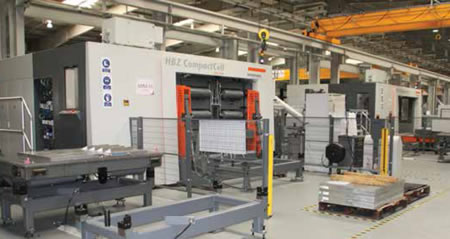 A main global supplier to Airbus, Stelia, Alenia Aermacchi, BAE Systems, Boeing, Dassault Aviation, Selex, and others, Abu Dhabi, UAE-based aerostructures component manufacturer Tawazun Precision Industries (TPI) relies on 5‐axis machining centers from German machine builder Handtmann A‐Punkt Automation GmbH to cover numerous applications. Seven Handtmann centers machine aluminum at high speeds, while machines from other manufacturers are dedicated to titanium.
A main global supplier to Airbus, Stelia, Alenia Aermacchi, BAE Systems, Boeing, Dassault Aviation, Selex, and others, Abu Dhabi, UAE-based aerostructures component manufacturer Tawazun Precision Industries (TPI) relies on 5‐axis machining centers from German machine builder Handtmann A‐Punkt Automation GmbH to cover numerous applications. Seven Handtmann centers machine aluminum at high speeds, while machines from other manufacturers are dedicated to titanium.
With orders increasing from Airbus, Boeing, and other aerospace customers, Kyle Wagner, operations manager, aerostructures at TPI, says, “A decrease in production volumes is not of any concern at all.”
Along with the international aerospace industry, TPI has been growing constantly for years. The company expects to increase its production by 50% each year for the next three years.
TPI managers try to keep a reasonable balance between aluminum and titanium machining to offer what the OEMs need, which corresponds to a material use ratio of about four to one.
TPI uses seven Handtmann 5‐axis machining centers for highspeed aluminum milling, covering more than 50 unique parts. The PBZ HD 600 profile machining center machines fuselage frames and cockpit frames, center wing boxes, and various beams up to 6,000mm in length. A maximum travel speed of 70m/min in X and 40m/min in Y and Z offers high performance in aluminum machining and appropriate cutting parameters. Two HBZ Compact Cell 200/100 horizontal machining centers – with 2,000mm x 1,000mm tables and stations for main‐time parallel setup – produce a mixture of structural parts, wing sections, and fuselage frames with a 30,000rpm high-power spindle. The centers have travel speeds of 60m/min in X and Z, and 40m/min in Y.
Four HBZ AeroCell 500/200 machines with 5,000mm x 2,000mm pallet sizes are used for high-speed machining of fuselage frames and various parts between cockpit and wings. Any HBZ AeroCell (AC) dedicated part can be machined on any of the four machines. The big pallet size allows several identical parts to be made from one aluminum plate. A 125kW, 30,000rpm spindle ensures high material removal rates and short machining times. The integrated pallet automation increases productivity.
Handtmann machines“These machines are brilliant for high-speed milling,” a TPI NC‐programmer says, referring to the HBZ AC as well as the HBZ CompactCell horizontal machining centers. The power the machines get from the horizontal concept combined with high spindle power produce high cutting rates and chip removal for quick cycle times.
Wagner is satisfied with the Handtmann machines’ performance. Cycle times are better than TPI estimated before buying the HBZ AC machines. Rapid feeds, good cutting rates, powerful machines, and efficiency result in satisfying productivity.
Machine operator Vivek is proud of the fact that he was the first person at TPI to touch a Handtmann machine and rates them user-friendly, highlighting the easy setup due to horizontally positioned pallets on the HBZ AC and HBZ CC, good chip removal system, and good visibility of the machining environment. The large HBZ AC also has a video camera for improved visibility while machining.
Capacity utilization on the TPI shop floor is around 100%, but TPI plans to increase the output by 50%. That increase is only possible with powerful machines and improved milling strategies. TPI doesn’t plan to invest in new machinery until current programs have been optimized.
 Handtmann HBC Compact Cell“We want to get the absolute maximum out of the machines. They are so powerful that there is still some potential by modifying and optimizing milling strategies, optimizing programs, and modifying tool selection to reach the best results possible. The machines are not the limitation. There’s still a lot of room for improvement,” according to Wagner. Besides process optimization, TPI will also set a higher priority on machine maintenance and service to keep the machines running smoothly.
Handtmann HBC Compact Cell“We want to get the absolute maximum out of the machines. They are so powerful that there is still some potential by modifying and optimizing milling strategies, optimizing programs, and modifying tool selection to reach the best results possible. The machines are not the limitation. There’s still a lot of room for improvement,” according to Wagner. Besides process optimization, TPI will also set a higher priority on machine maintenance and service to keep the machines running smoothly.
As TPI produces 24/7, machine reliability is most important. According to Wagner, spare part deliveries, reaction times, remote diagnostics, problem solving, and training are considered as very industry with a significant role in the international aero structures supply chain because of an excellent reputation for on‐time delivery, on‐time quality, and cost competitiveness, Wagner says.
Article by Robert Schoenberger. Reprinted with permission.
